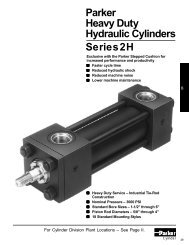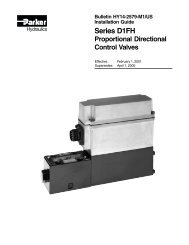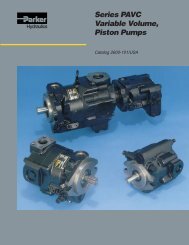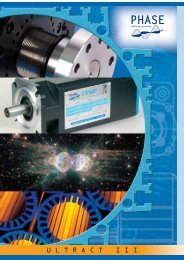Axial Piston Pump Series PV
Axial Piston Pump Series PV
Axial Piston Pump Series PV
Create successful ePaper yourself
Turn your PDF publications into a flip-book with our unique Google optimized e-Paper software.
Catalogue HY11-3243/UK<br />
Horse power compensators<br />
Hydraulic-mechanical horse power compensator<br />
The hydraulic-mechanical horse power compensator<br />
consists of a modified remote pressure compensator<br />
(Code *L*) or of a modified load-sensing compensator<br />
(Code *C*) and a pilot valve. This pilot valve is integrated<br />
into the pump and is adjusted by a cam sleeve. The cam<br />
sleeve has a contour that is designed and machined for<br />
the individual displacement and the nominal horse power<br />
setting.<br />
At a large displacement the opening pressure (given by<br />
the cam sleeve diameter) is lower than at small displacements.<br />
This makes the pump compensate along a<br />
constant horse power (torque) curve (see diagrams on<br />
opposite page).<br />
For all nominal powers of standard electrical motors<br />
Parker offers a dedicated cam sleeve. The exchange of<br />
this cam sleeve (e. g.: to change horse power setting) can<br />
easily be done without disassembly of the pump.<br />
On top of that an adjustment of the horse power setting<br />
can be done within certain limits by adjusting the preload<br />
of the pilot control cartridge spring . That allows an<br />
adjustment of a constant horse power setting for other<br />
than the nominal speeds (1500 min -1 ) or for other horse<br />
powers.<br />
PM P<br />
L<br />
L<br />
P M<br />
S L<br />
P<br />
S L<br />
PI <strong>PV</strong>plus UK.PM6.5 RH<br />
T P<br />
T<br />
P<br />
Ø0,8<br />
P1 A<br />
P1 A<br />
P L<br />
horse power<br />
comp., pilot flow<br />
internal interface<br />
on top<br />
code *LA<br />
L P1 A<br />
PM P L<br />
P1 A<br />
S L<br />
32<br />
<strong>Axial</strong> piston pump<br />
<strong>Series</strong> <strong>PV</strong><br />
P P<br />
P L<br />
PM<br />
L<br />
P L<br />
S L<br />
L<br />
L<br />
L<br />
P1 P1 A<br />
A PL PM P L<br />
horse power<br />
compensator,<br />
pilot flow external<br />
for load-sensing<br />
code *CB<br />
Note:<br />
If version *CB<br />
is required with an external pilot<br />
valve and Ø0.8 mm orifice, the orifice<br />
in port PF has to be removed.<br />
Ordering code for the horse power option<br />
The first digit designates the horse power setting:<br />
Code B = 3.0 kW etc. up to<br />
Code 3 = 132.0 kW<br />
The second digit designates the pilot flow source:<br />
Code L internal pilot pressure, remote pressure function.<br />
Code C external pilot pressure, combines horse power<br />
compensation with load-sensing compensation.<br />
The third digit designates the possibility to adjust the<br />
overriding pressure compensation:<br />
Code A comes with a top side NG6/D03 interface on<br />
the control valve to mount any suitable pilot<br />
valve or Parker pump accessories.<br />
Code B has a threaded pilot port P p (G1/4) to connect<br />
a remote pilot valve with piping.<br />
Code C includes a pilot valve for manual pressure<br />
adjustment. Max. setting: 350 bar.<br />
Page 33 shows typical control characteristics and the<br />
available horse power settings for the different pump<br />
sizes and displacements.<br />
horse power<br />
compensator,<br />
pilot flow internal<br />
code *LB<br />
= included<br />
S L<br />
T<br />
T P<br />
T<br />
P 1<br />
P1<br />
P 1<br />
P1<br />
T P<br />
Parker Hannifin GmbH<br />
Hydraulic Controls Division<br />
Kaarst, Germany<br />
P<br />
P<br />
A<br />
A<br />
A<br />
A<br />
P F<br />
P L<br />
PL<br />
horse power comp.,<br />
pilot flow internal<br />
pressure pilot valve<br />
included<br />
code *LC<br />
horse power comp.,<br />
pilot flow external<br />
for load-sensing,<br />
pilot valve included<br />
code *CC






